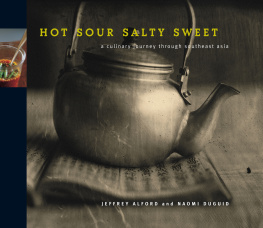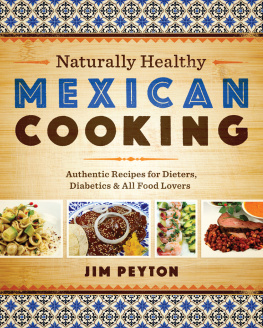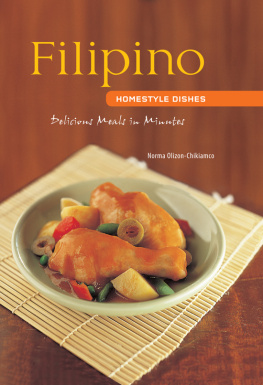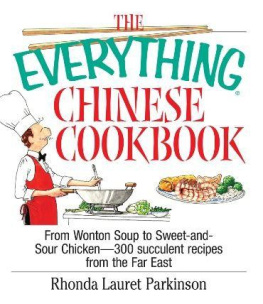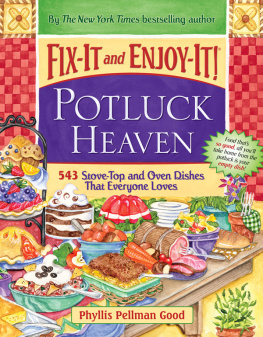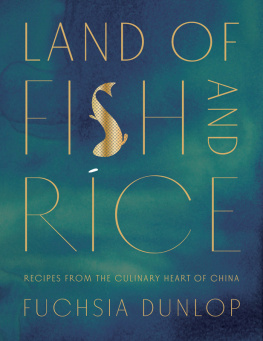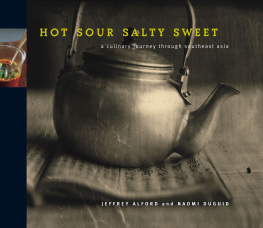ABOUT THE AUTHORS

JEFFREY ALFORD is a writer and photographer based primarily in northeast Thailand and Cambodia. He plants and harvests rice each year; helps raise frogs and several varieties of fish; and happily struggles along in three languages: Central Thai, Lao Isaan, and Northern Khmer. His forthcoming book, to be published in 2014, is tentatively titled How Pea Cooks: Food and Life in a Thai-Khmer Village. His earlier books, all co-written with Naomi Duguid, are Flatbreads and Flavors; HomeBaking; Seductions of Rice; Hot Sour Salty Sweet; Mangoes and Curry Leaves; and Beyond the Great Wall. Jeffrey is currently developing a series of intensive culinary tours through northeastern Thailand and western Cambodia (the Angkor Wat area) under the name of Heritage Food Thailand.
Authors Website: hotsoursaltysweet.com

NAOMI DUGUID is a writer, photographer, great cook, and intrepid traveler who explores the world through the lens of food. She is a contributing editor of Saveur magazine and writes the bimonthly Global Pantry column in Cooking Light. Every winter she conducts an intensive cultural-immersion-through-food course in Chiang Mai, Thailand, called ImmerseThrough, and also guides a food-focused tour to Burma. Duguid is the author of, most recently, Burma: Rivers of Flavor. Her earlier books, all co-written with Jeffrey Alford, are Flatbreads and Flavors; HomeBaking; Seductions of Rice; Hot Sour Salty Sweet; Mangoes and Curry Leaves; and Beyond the Great Wall. Her weekly posts at www.naomiduguid.blogspot.com explore ideas about food and life; she can be reached at naomiduguid.com. Her next project is a book that celebrates Persian culinary traditions, tentatively titled The Persian World.
Also by Jeffrey Alford and Naomi Duguid
Beyond the Great Wall
Mangoes & Curry Leaves
HomeBaking
Seductions of Rice
Flatbreads & Flavors
HOT SOUR SALTY SWEET
A Culinary Journey Through Southeast Asia
Jeffrey Alford and Naomi Duguid
Studio photographs by Richard Jung
Location photographs by Jeffrey Alford and Naomi Duguid
ARTISAN NEW YORK
Copyright 2000 by Jeffrey Alford and Naomi Duguid
Location photographs copyright 2000 by Jeffrey Alford and Naomi Duguid
Studio photographs copyright 2000 by Richard Jung
Food styling by Sandra Cook
Prop styling by Sara Slavin
All rights reserved. No portion of this book may be reproducedmechanically, electronically, or by any means, including photocopyingwithout written permission of the Publisher.
Published by Artisan
A Division of Workman Publishing, Inc.
225 Varick Street
New York, New York 10014-4381
www.artisanbooks.com
Library of Congress Cataloging-in-Publication Data is available
eISBN 9781579655648
To Dom and Tashi, with love and thanks for being such great traveling companions
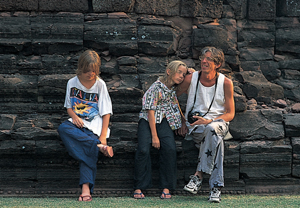
PREFACE:
We first started traveling (and eating) in Southeast Asia years ago, in the seventies. For a long time, because of the war in Vietnam and changes brought about by the war, we could travel only in Thailand and for short stays in Burma. In the mid-1980s, travel restrictions in China loosened up, and parts of Chinas Yunnan Province became open to outsiders. In the late 1980s, restrictions on travel to Laos, Vietnam, and Cambodia also loosened; we first went to Laos in 1989, and to Vietnam a few months later. By the mid-1990s, we were able to travel by land from mountainous northern Vietnam into China, and from China into remote northern Laos, crossing land borders that had been closed to outsiders for decades.
The more we traveled, the more we became aware of close relationships within the region in terms of food and culture. Our culinary map of Southeast Asia slowly changed, no longer grouping Thailand together with Malaysia and Indonesia, as is traditionally done, but seeing it as a close cousin to parts of southwest China (Yunnan) and to the Shan State in Burma, as well as to Laos, Cambodia, and Vietnam. Just as we think of the Mediterranean as having a common palate, we began to see mainland Southeast Asia in the same way. That uniquely wonderful food, the food wed originally been introduced to in Thailand, we came to realize, was unique to an entire region, not to just one country.
In 1997, confident that Southeast Asia would continue to open its doors, we eagerly began work on this cookbook. Our goal was to eat our way from village to village, town to town, sometimes returning to places where wed been before, sometimes crossing borders into regions new to us. Would there, we wondered, be fish sauce in southern Yunnan? Would cooks in Cambodia brown their garlic the way Thais do, and would they rub grilled meats with black pepper and ground coriander root? If there were indeed a shared palate throughout the region, what would be its essential characteristics? In the Mediterranean, there is a common approach to food, but Moroccan and Greek are hardly close cousins. In mainland Southeast Asia, what would be the similarities among the cuisines, and the differences?
When we first began, eating and traveling, taking photographs, we felt as if we were working on a giant jigsaw puzzle, tracking ingredients, methods, dishes, names, and so on. But as time went by, we found ourselves gravitating toward the Mekong river, as if the river were a well-worn trail through the forest. The Mekong (Mae Khong, or River Khong, in Thai) flows south through China from its source in Tibet, draws the border between Burma and Laos, and then between Laos and Thailand. It flows on down through Cambodia before reaching its massive delta in the southern part of Vietnam. Along the way, tributaries flow into it, swelling it with water from distant hills.
The Mekong watershed doesnt define the food and cooking of Southeast Asia, but, like the Mediterranean Sea, the Mekong and its tributaries are an integral part of the regions food. They carry and deposit fertile soil for dry-season gardens. They irrigate rice fields and support an abundant fish and plant life. They help transport goods and people, and at times are the only roads around. And in the heat of the day, the river is always there for a cool swim.
The Mekong became our thread, our compass. Whenever possible, we tried to travel down the river, from Huay Xai in Laos to Luang Prabang, from Cantho to Tra Vinh, getting lost in the massive Deltas tangle of waterways. When river travel wasnt possible, we took small nearby roads. Always we searched for key locations along the river to settle into, places that had been important historically, or places simply too beautiful, or too interesting, to pass by.
And just as the river became our road, village life became our point of reference. Traveling in Southeast Asia, we have always been happier eating in small towns and villages than in big cities. It seems that it should be the opposite, because in the city there is so much more food to choose from, and so many more ingredients for cooks to cook with. Bangkok, Ho Chi Minh City, and Kunming are all incredible places to eat, places where we have enjoyed some of the best meals weve ever had. But give us a choice, and we will almost always choose to eat, and to spend time, in smaller towns and villages.

